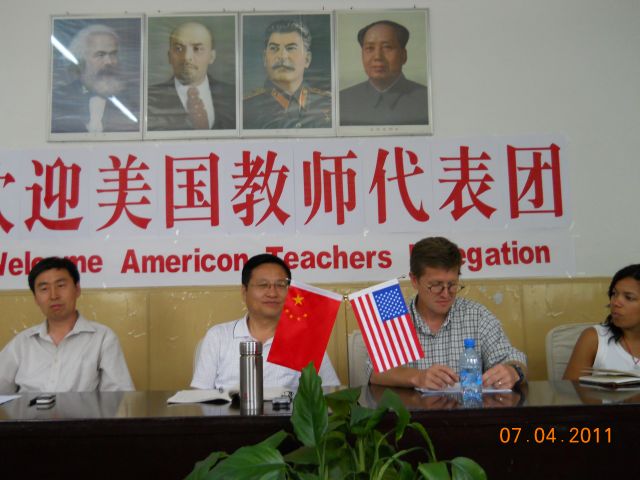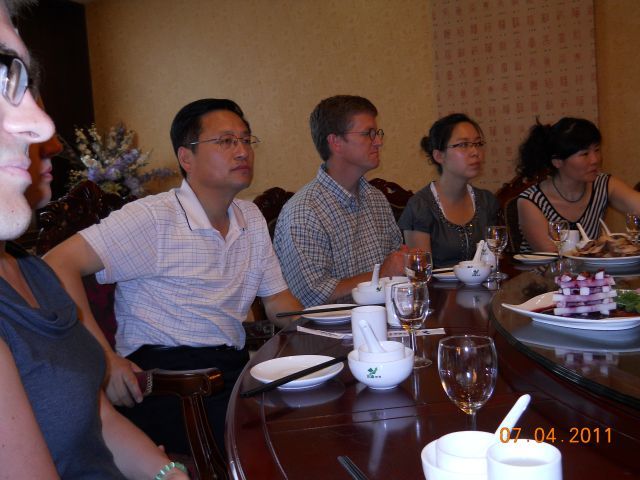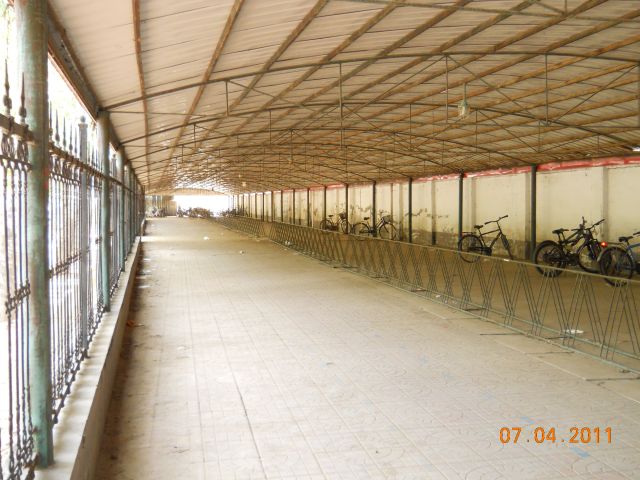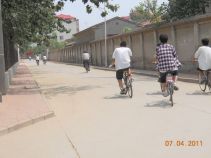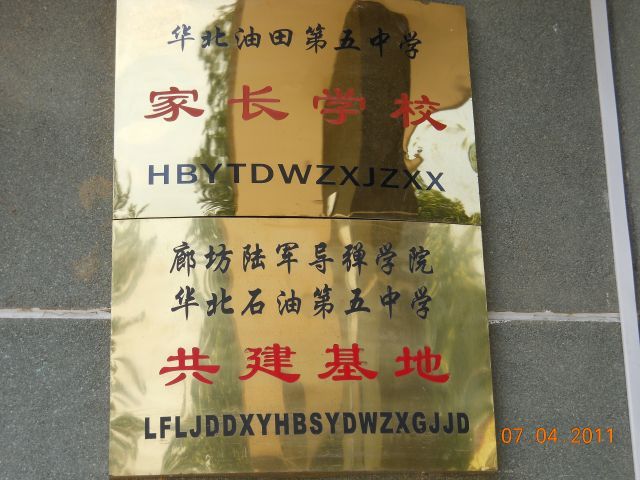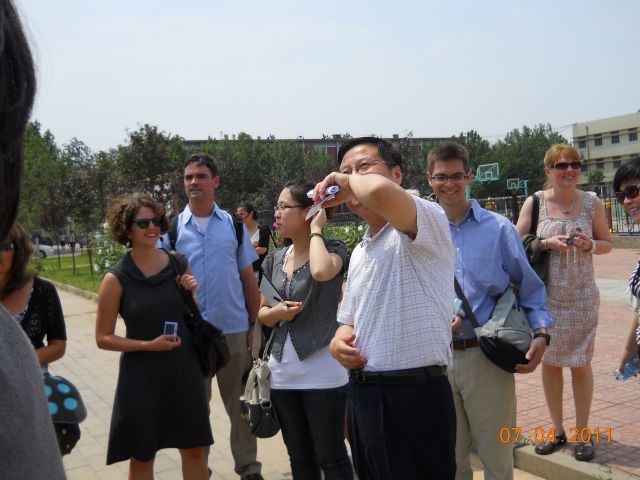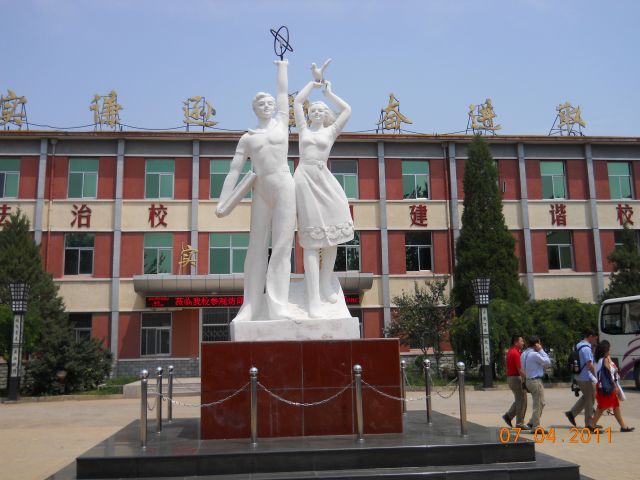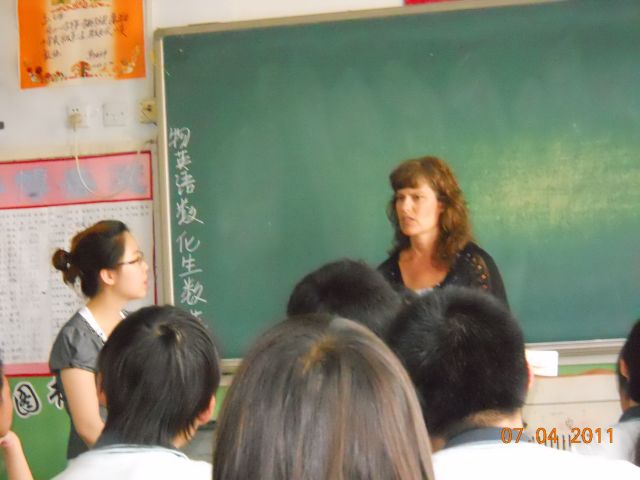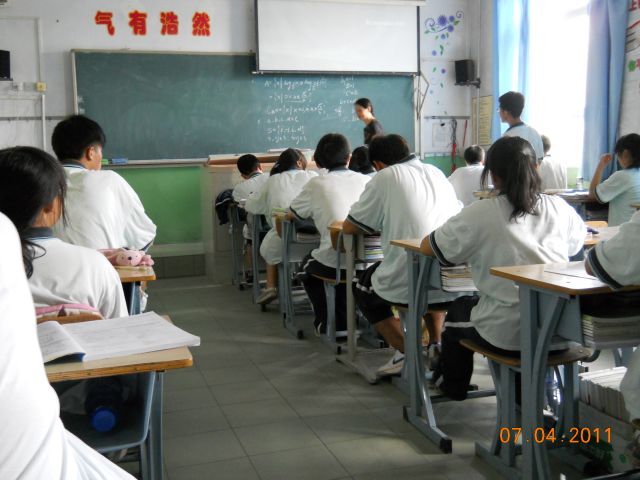My blog is a few days late. I wrote it late night on the day we went to the Great Wall, but have not found the time or internet access to upload it from David’s computer.
I learned today that Mau once said that one is not a “man” (or hero/heroine) if he (or she) does not climb the Great Wall. Well today, it would seem, I became a man because I climbed the wall. Here’s the way the day went…
We woke up, ate an early breakfast at Maxim on the second floor of our hotel, and met with our tour guide Peter on the bus at 8:30 AM. On our drive to the Great Wall, which is in the Western Hills – northwest of Beijing – we stopped at a jade factory. At the factory we followed a tour guide who taught us about jade and the factory. I was impressed by the many different colors of jade at the factory. Before this visit I thought jade only came in shades of green, but there are yellows, whites, shades of orange, reds, and other colors. There is even a translucent type of jade that reminded me of alabaster. I was also impressed that carvings, small and large, are made out of one piece of jade. I found the carving by the factory workers to be interesting. The work seems very detailed and difficult. I worried about the workers as they exposed themselves to fine dust particles that came from drilling. It would seem appropriate to wear a mask, but perhaps the dust is innocuous. Finally, I was impressed by what jade looks like in its natural form. Without cutting and polishing, jade naturally looks like any other rock. After looking through the showroom and allowing some time for purchases, the group went back to the bus and we were off to the Great Wall.
On the journey up to the wall, I was immediately impressed by the landscape. The mountains (really just foothills) were steep and jagged. Someone even asked “why did they need to build a wall up here?” Peter filled us in on factual details about the wall and I gave a brief talk on “what the wall is and what it represents.” I suggested that the answer to these questions depends on one’s perspective based on where he or she is in time and space. The wall has served to separate and unify people at different points in its history. For example, the first emperor Shi Huang not only built the wall to keep out the Xiongnu, but he also used the wall to help unify the various peoples of China. Today the wall is a meeting place for people from all over the world. However, on a more modern note, the “Great Red Firewall” limits the free exchange of information.
We finally reached the Great Wall at about 11:00 AM. We determined that we would meet at a coffee shop in a hotel near the famous Badaling Entrance after only two short hours. (To be fair we started the clock once we got in the gate – thanks David!) We got our group ticket, went through the turn style, and we were off to the races. A group of us immediately determined that we would take the steeper southern route to move away from the incredible crowds going north. Peter was correct when he defined this route as steep; it was very steep, so steep in fact that I imagined skiing down the wall. If the stones had been wet or slick, there would have be no way to make it up certain parts of the slope. With this in mind, one wonders how the builders of the wall managed the terrain. Building the wall was certainly a great feat. It’s not only the largest structure in cubic meters and length that humans have ever built (4000-5000 miles long depending on how you look at it), the terrain is so rugged, it must have been ridiculous to put together. No wonder so many people died building the wall, over one million according to some sources.
The views one can see on the wall are spectacular and I recommend making the trip to see them. The mountains remind me of the San Bernardino Mountains in California. The rock is reddish in color and, although there are more trees, there is scrub brush like in CA. The environment also looks like it can get very dry and dusty, which is also similar. The huge difference is the massive, dragon-like structure that winds its way back and forth and up and down over the mountains for as far as the eye can see. After “reaching Mongolia” as we were told by a t-shirt merchant, our small group broke up and I went to huff up the other northern side of the wall. I made it to the high point, but only by fighting through the massive crowds I met along the way. I did not make it to the end of the northern trail. I needed to turn around to make it back to the coffee shop on time, but I am glad I made the effort. Walking through the crowds, I heard languages from all over the world, including a man on a cell phone speaking Swedish. I stopped to listen to his sing-songy language and then moved up the hill. I also noted some very strong smells. People were hot, sweaty, and children who could not make it to a bathroom let it go on the wall, especially in the watch towers where clean-up workers were making their rounds. Navigating the mass of humanity on the northern part of the wall was a “great” experience in its own right. Moving through this mass takes a bit of perseverance and patience.
After descending from the wall, getting a drink, ice cream, or both, the group was off to a cloisonné factory and lunch. On route, the bus had small run in with a truck that was apparently one of the many coal trucks that consistently cause traffic jams on small roads throughout the area. At the cloisonné factory we again viewed crafts people at work, as well as their beautiful finished products. After walking through the factory floor showroom, we went upstairs to a restaurant where we ate lunch. The food was very good, but I will recommend standing up slowly before asking for more fish balls.
Following lunch, the group went off to the Ming Tombs. Chris provided the group with a historical perspective and Peter gave the group a tour of the tombs. The tombs were impressive with large barrel vaulted chambers, buried far below ground under large circular sandstone block mounds that were covered with cypress trees.
After the visit to the Ming Tombs, Morrell and I went to see a Chinese opera. Peter went out of his way by taking us to the opera house on his way home from work. He even took us into the building, gave us a personalized tour, and explained what we would see. Peter was awesome and went way beyond the call of duty to make sure we had a nice time.
The opera we saw was shorter than a normal opera, just over one hour long instead of the normal two to three hour performance. This opera was made up of scenes from a few well known operas and designed for a foreign audience; that is, there were English subtitles. The costumes were fascinating and the face/mask painting was incredible. I was particularly impressed by the acrobatics and the choreography in the scene about the Monkey King. I am not quite sure how the actors made their bodies do some of the moves I saw.
Finally after returning from the opera, Morrell and I went to a bakery to get a snack and food for the next day’s breakfast. I then ran off to Tiananmen Square one last time to get a few nighttime pictures. Tomorrow we are off to a school in Longfang in the Hebei province and then we will take an overnight train to Hang Zou.

